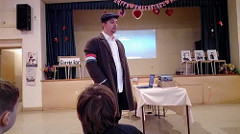Do you wonder what an irregular lesson about literature is like?
 How can you explain the meaning of the revolution to 10-year-old kids who were born outside of Hungary and never visited their old country?
How can you explain the meaning of the revolution to 10-year-old kids who were born outside of Hungary and never visited their old country?
The topic of 1956 is still contradictory in many views.
The older generation, who took part in the revolution, has a certain view about it, which is different form the opinions of the Generation-X who were not even supposed to talk about it for decades except whispering about it quietly at home. And then, the Millennials who have yet another meaning of the revolution; for them ’56 is only a subject that is remembered by the obligatory memorials in every school year.
Is it possible to explain the kids the suffocating atmosphere of communism, in which Hungary was stuck during the ’50s.
Can they imagine themselves back in those times and feel, understand what the young people were protesting against, so that the events of 1956 will not remain for them some boring data from history about a country, which is complicated, chaotic, and where they have never been.
This was the challenging task for Lóránt Tóth Péter, who calls himself as the travelling poet. We met him in his irregular class of Literature in Montréal. Having a degree in teaching history, he claims his mission is to make the youth of the Hungarian diaspora know and love poems. He presented his performance called Forr-A- Dal-Már (Hung. Singing of the Revolution) that projects the revolution of ’56 in a different light.
The audience gathered in the community hall of the protestant church of Montréal showed a really composite picture, all the three generations mentioned above were present: survivors of the bloody revolution, the generation who were silenced and had to live through consequences of the revolution, and the children born in Canada for whom the subject is dim and distant.
But the travelling poet was not perplexed by neither the inhomogenous public nor the inconveniences caused by jet lag.
To bring the forced expropriations of communism closer to the kids, he confiscated the valueables of the audience at the beginning of the show, which caused a stormy dejection.
Then he brought up very basic and simple examples to show how the communist regime intruded into the every day life of the people crating suspicion and mistrust in relationships at all levels. He expressed through poems the frustration and despair of the people in a world where a privileged few had everything, and the rest had nothing; where there were no rights, and people were afraid not only of spies, but often of themselves knowing that everyone can be tortured so cruelly that they will sign any paper put in front of them. He described this hopeless period in such a realistic way that the news that the revolution had broken out was an actual relief, and the crowds willingly went protest to the Bem square… He emphazied the role of people under 18 in the fights going into such detailds as the jokes that were passed around after the toppling of Stalin’s statue, so that kids can have an idea about atmosphere of those two glorious weeks. The performance was supported by a rich collection of archive pictures and videos.
He presenting the sad aftermath, the opression and retribution of the revolution, the overall message of the show was still positive saying we should appreciate our freedom, so that those youngsters didn’t shed their blood in vein. Let’s do everything we can to use our talents to make the world a better place.
Because life prevails over death.
Photos about the event are posted here.
Dorka Kornélia Takácsy, KCSP, Montréal